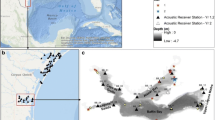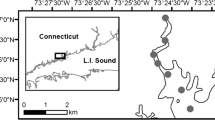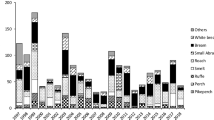Abstract
Diadromous fish use both freshwater and marine habitats to complete their life cycles, but dams restrict those connections, and as a result, many populations are historically low across their range. The Penobscot River, Maine, USA, once had large populations of diadromous fish and has recently been the focus of large restoration projects. Our objective was to assess the river restoration impacts in the estuary using mobile, multi-frequency echosounders (SIMRAD EK60 split-beam 38 and 120 kHz) to construct a time series of fish distribution using metrics of fish length and fish density, both seasonally and pre-restoration (2012–2014) versus post-restoration (2015–2019). Seasonally, fish size was the smallest in summer, while density and biomass were greater as compared to spring and fall. Between pre- and post-restoration years, fish length did not differ, and with a median of 4.7 cm, median density increased from less than 0.5 fish m−2 to greater than 1 fish m−2. Fish biomass was approximately three times greater in post-restoration years where it ranged 23 to 316 mt per survey than pre-restoration years where it ranged from 9 to 114 mt per survey. These patterns are consistent with a system undergoing restoration of migratory fish where larger adult fish migrate in the spring and their juveniles in the summer and fall. This study demonstrates the ecological impacts of river restoration on its estuary by quantifying multiple metrics (fish biomass, density, and size).








Similar content being viewed by others
Data Availability
The data that support the findings of this study that can be shared publicly are openly available in InPort at https://www.fisheries.noaa.gov/inport, at ID number 27491. Further inquiries can be directed to the corresponding author.
References
Able, K.W. 2005. A re-examination of fish estuarine dependence: Evidence for connectivity between estuarine and ocean habitats. Estuarine, Coastal and Shelf Science 64: 5–17.
Ames, E.P. 2004. Atlantic cod stock structure in the Gulf of Maine. Fisheries 29 (1): 10–28.
Ames, E.P., and J. Lichter. 2013. Gadids and alewives: Structure within complexity in the Gulf of Maine. Fisheries Research 141: 70–78.
Bellmore, J.R., J.J. Duda, L.S. Craig, S.L. Greene, C.E. Torgersen, M.J. Collins, and K. Vittum. 2017. Status and trends of dam removal research in the United States. Wiley Interdisciplinary Reviews: Water 4 (2): 1–13.
Bernhardt, E.S., M.A. Palmer, J.D. Allan, G. Alexander, K. Barnas, S. Brooks, J. Carr, S. Clayton, C. Dahm, J. Follstad-Shah, D. Galat, and 2005 Synthesizing US river restoration efforts. Science, 308, 636–637.Able, K.W. 2005. A re-examination of fish estuarine dependence: evidence for connectivity between estuarine and ocean habitats. Estuarine, Coastal and Shelf Science 64 (1): 5–17.
Bertsekas, D. 1990. The auction algorithm for assignment and other network flow problems: A tutorial. Interfaces 20 (4): 133–149.
Blackman, S.S. 1986. Multiple-target tracking with radar applications, 449. Norwood, MA: Artech House Inc.
Day, L.R. 2006. Restoring native fisheries to Maine’s largest watershed: The Penobscot River Restoration Project. Journal of Contemporary Water Research & Education 134 (1): 29–33.
Dennis, B., and G.P. Patil. 1984. The gamma distribution and weighted multimodal gamma distributions as models of population abundance. Mathematical Biosciences 68: 187–212.
Deroba J. 2015. Atlantic herring operational assessment report 2015. Department Commerce, Northeast Fisheries Science Center Reference Document. 19–02; 56 p. https://www.nefsc.noaa.gov/publications/
Dias, B.S., M.G. Frisk, and A. Jordaan. 2019. Opening the tap: increased riverine connectivity strengthens marine food web pathways. PLoS One 14 (5): e0217008
Echoview Software Pty Ltd. 2018. Echoview software, version 8.0.104.32739. Echoview Software Pty Ltd, Hobart, Australia.
Foley, M.M., J.R. Bellmore, J.E. O’Connor, J.J. Duda, A.E. East, G.E. Grant, C.W. Anderson, J.A. Bountry, M.J. Collins, P.J. Connolly, and L.S. Craig. 2017. Dam removal: Listening in. Water Resources Research 53 (7): 5229–5246.
Foote, K.G. 1987. Fish target strengths for use in echo integrator surveys. The Journal of the Acoustical Society of America 82 (3): 981–987.
Gardner, C., S.M. Coghlan Jr., J. Zydlewski, and R. Saunders. 2013. Distribution and abundance of stream fishes in relation to barriers: Implications for monitoring stream recovery after barrier removal. River Research and Applications 29: 373–385.
Geyer, W.R., and D.K. Ralston. 2018. A mobile pool of contaminated sediment in the Penobscot Estuary, Maine, USA. Science of the Total Environment 612: 694–707.
Guyette, M.Q., C.S. Loftin, J. Zydlewski, and R. Cunjak. 2014. Carcass analogues provide marine subsidies for macroinvertebrates and juvenile Atlantic salmon in temperate oligotrophic streams. Freshwater Biology 59 (2): 392–406.
Haefner, P.A. 1967. Hydrography of the Penobscot River (Maine) Estuary. Journal of the Fisheries Research Board of Canada. 24: 1553–1571.
Hagan, S.M., and K.W. Able. 2003. Seasonal changes of the pelagic fish assemblage in a temperate estuary. Estuarine, Coastal and Shelf Science 56 (1): 15–29.
Hall, C.J., A. Jordaan, and M.G. Frisk. 2011. The historic influence of dams on diadromous fish habitat with a focus on river herring and hydrologic longitudinal connectivity. Landscape Ecology 26 (1): 95–107.
Hall, C.J., A. Jordaan, and M.G. Frisk. 2012. Centuries of anadromous forage fish loss: Consequences for ecosystem connectivity and productivity. BioScience 62 (8): 723–731.
Hartman, K.J. 2003. Population-level consumption by Atlantic coastal striped bass and the influence of population recovery upon prey communities. Fisheries Management and Ecology 10: 281–288. https://doi.org/10.1046/j.1365-2400.2003.00365.x.
Hart, D.D., T.E. Johnson, K.L. Bushaw-Newton, R.J. Horwitz, A.T. Bednarek, D.F. Charles, D.A. Kreeger, and D.J. Velinsky. 2002. Dam removal: Challenges and opportunities for ecological research and river restoration: We develop a risk assessment framework for understanding how potential responses to dam removal vary with dam and watershed characteristics, which can lead to more effective use of this restoration method. AIBS Bulletin 52 (8): 669–682.
Horne, J.K., and J.M. Jech. 1999. Multi-frequency estimates of fish abundance: Constraints of rather high frequencies. ICES Journal of Marine Science 56 (2): 184–199.
Hogg, R.S., S.M. Coghlan Jr., J. Zydlewski, and K.S. Simon. 2014. Anadromous sea lampreys (Petromyzon marinus) are ecosystem engineers in a spawning tributary. Freshwater Biology 59 (6): 1294–1307.
Hogg, R.S., S.M. Coghlan Jr., J. Zydlewski, and C. Gardner. 2015. Fish community response to a small-stream dam removal in a coastal Maine tributary. Transactions of the American Fisheries Society 144: 467–479.
Huang, H., J.M. Winter, E.C. Osterberg, R.M. Horton, and B. Beckage. 2017. Total and extreme precipitation changes over the Northeastern United States. Journal of Hydrometeorology 18 (6): 1783–1798.
Jech J.M. 2014. Postprocessing of scientific echo-sounder data from the NOAA ships Albatross IV and HB Bigelow: 1998–2012. Northeast Fisheries Science Center, Reference Document 14-08, Woods Hole, Massachusetts.
Leach, L., M. Simpson, J.R. Stevens, and K. Cammen. 2022. Examining the impacts of pinnipeds on Atlantic salmon: The effects of river restoration on predator–prey interactions. Aquatic Conservation: Marine and Freshwater Ecosystems 32 (4): 645–657.
Lipsky CA, Saunders R, Stevens JR, O’Malley M, Music P. 2019. Developing sampling strategies to assess the Penobscot River estuary (2010–2013). Department Commerce, Northeast Fisheries Science Center Reference Document. 19–02; 56 p. https://www.nefsc.noaa.gov/publications/
Livingston, R.J. 1987. Field sampling in estuaries: The relationship of scale to variability. Estuaries 10: 194–207.
Limburg, K.E., and J.R. Waldman. 2009. Dramatic declines in North Atlantic diadromous fishes. BioScience 59 (11): 955–965.
MacLennan, D.N., P.G. Fernandes, and J. Dalen. 2002. A consistent approach to definitions and symbols in fisheries acoustics. ICES Journal of Marine Science 59 (2): 365–369.
Maine Department of Marine Resources and Maine Department of Inland Fisheries and Wildlife (MDMR and MDIFW). 2009. Operational plan for the restoration of diadromous fishes to the Penobscot River. MDMR, Department of Inland Fisheries and Wildlife, Final Report, Augusta.
Martin, E.H. and C.D. Apse. 2011. Northeast aquatic connectivity: an assessment of dams on northeastern rivers. The Nature Conservancy, Eastern Freshwater Program, Brunswick, ME.
McDermott, S.P., N.C. Bransome, S.E. Sutton, B.E. Smith, J.S. Link, and T.J. Miller. 2015. Quantifying alosine prey in the diets of marine piscivores in the Gulf of Maine. Journal of Fish Biology 86 (6): 1811–1829.
McFadden D. 1974. Conditional logit analysis of qualitative choice behavior in Zarembka P. (Ed.), Frontiers in Econometrics, Academic Press 105–142.
MEDMR (Maine Department of Marine Resources), 2018, http://www.maine.gov/dmr/science-research/searun/programs/trapcounts.html. Accessed 12/5/2018.
Mills, K.E., A.J. Pershing, C.J. Brown, Y. Chen, F.S. Chiang, D.S. Holland, S. Lehuta, J.A. Nye, J.C. Sun, A.C. Thomas, and R.A. Wahle. 2013. Fisheries management in a changing climate: Lessons from the 2012 ocean heat wave in the Northwest Atlantic. Oceanography 26 (2): 191–195.
Molina-Moctezuma, A., E. Peterson, and J.D. Zydlewski. 2021. Movement, survival, and delays of Atlantic salmon smolts in the Piscataquis River, Maine, USA. Transactions of the American Fisheries Society 150 (3): 345–360.
NOAA SEAB, (National Oceanic and Atmospheric Administration Strategic Environmental Assessment Branch), 1985. National estuarine inventory: Data atlas, Volume 1: Physical and hydrologic characteristics. Rockville, MD: NOAA.
O’Connor, J.E., J.J. Duda, and G.E. Grant. 2015. 1000 dams down and counting. Science 348 (6234): 496–497.
O’Malley, M.B., R. Saunders, J.R. Stevens, J.M. Jech, and T.F. Sheehan. 2017. Using hydroacoustics to describe pelagic fish distribution in the Penobscot Estuary, Maine. Transactions of the American Fisheries Society 146 (5): 817–833.
Ouellet, V., M.J. Collins, J.F. Kocik, R. Saunders, T.F. Sheehan, M.B. Ogburn, and T. Trinko Lake. 2022. The diadromous watersheds-ocean continuum: Managing diadromous fish as a community for ecosystem resilience. Frontiers in Ecology and Evolution 10: 1007599.
Palmer, M.A., E.S. Bernhardt, J.D. Allan, P.S. Lake, G. Alexander, S. Brooks, J. Carr, S. Clayton, C.N. Dahm, J.F. Shah, and D.L. Galat. 2005. Standards for ecologically successful river restoration. Journal of Applied Ecology 42 (2): 208–217.
Pess, G.R., T.P. Quinn, S.R. Gephard, and R. Saunders. 2014. Re-colonization of Atlantic and Pacific rivers by anadromous fishes: Linkages between life history and the benefits of barrier removal. Reviews in Fish Biology and Fisheries 24 (3): 881–900.
Potter, I.C., Claridge, P.N. and Warwick, R.M., 1986. Consistency of seasonal changes in an estuarine fish assemblage. Marine Ecology Progress Series, pp.217–228.
R Core Team 2018. R: a language and environment for statistical computing. R Foundation for Statistical Computing, Vienna, Austria. http://www.R-project.org/)
Recksiek, C.W., and J.D. McCleave. 1973. Distribution of pelagic fishes in the Sheepscot River Back River Estuary, Wiscasset, Maine. Transactions of the American Fisheries Society 102 (3): 541–551.
Rotherham, D., M.G. Chapman, A.J. Underwood, C.A. Gray, and D.D. Johnson. 2011. Untangling spatial and temporal variation in abundances of estuarine fish sampled with multi-mesh gillnets. Marine Ecology Progress Series 435: 183–195.
Saunders, R., M.A. Hachey, and C.W. Fay. 2006. Maine’s diadromous fish community: Past, present, and implications for Atlantic salmon recovery. Fisheries 31 (11): 537–547.
Sheehan, T.F., M.P. Wynne, G.A. Clarke, S. Coghlan, M. Collins, A. Kelley, R. Kelshaw, D. Kusnierz, J. Royte, R. Saunders, C. Schmitt, K. Wilson, G. Zydlewski, J. Zydlewski. 2021. Implementing a monitoring framework and data archive for dam removal: pre-project ecological monitoring of the lower Penobscot River, Maine USA. US Dept Commer, NOAA Technical Memorandum NMFS-NE-272 p. Available from: https://repository.library.noaa.gov/view/noaa/34051
Simmonds, J. and D.N. MacLennan. 2005. Fisheries acoustics: theory and practice. John Wiley & Sons. 438 pp.
Stevens, J.R. 2019. Response of estuarine fish biomass to restoration in the Penobscot River, Maine. [masters thesis]. The University of Maine.
Stevens, J.R., J.M. Jech, G.B. Zydlewski, and D.C. Brady. 2021b. Estimating target strength of estuarine pelagic fish assemblages using fisheries survey data. The Journal of the Acoustical Society of America 150 (4): 2553–2565.
Stevens, J.R., R. Saunders, and W. Duffy. 2021a. Evidence of life cycle diversity of river herring in the Penobscot River Estuary. Maine. Marine and Coastal Fisheries 13 (3): 292–305.
Stich, D.S., G.B. Zydlewski, J.F. Kocik, and J.D. Zydlewski. 2015. Linking behavior, physiology, and survival of Atlantic salmon smolts during estuary migration. Marine and Coastal Fisheries, 7(1), pp.68–86.
USGS (United States Geological Survey) 2018. National Water Information System: Web Interface. https://waterdata.usgs.gov/nwis.
Watson, J.M., S.M. Coghlan Jr., J. Zydlewski, D.B. Hayes, and I.A. Kiraly. 2018. Dam removal and fish passage improvement influence fish assemblages in the Penobscot River, Maine. Transactions of the American Fisheries Society 147 (3): 525–540.
Weaver, D.M., S.M. Coghlan Jr., H.S. Greig, A.J. Klemmer, L.B. Perkins, and J. Zydlewski. 2018. Subsidies from anadromous sea lamprey (Petromyzon marinus) carcasses function as a reciprocal nutrient exchange between marine and freshwaters. River Research and Applications 34 (7): 824–833.
Acknowledgements
We thank Michael O’Malley for his role in refining acoustic survey methods and data processing protocols. We thank Rory Saunders, Tim Sheehan and Christine Lipsky for their contribution to the conceptual design of the estuary survey and the overall Penobscot River monitoring efforts. We thank the various staff and interns at the National Oceanic and Atmospheric Administration (NOAA) Northeast Fisheries Science Center Atlantic Salmon Ecosystems Research Team for support in conducting acoustic surveys especially Dr. John Kocik.
Funding
Reference to any specific commercial product, process, or service or the use of any trade, firm, or corporation name is for the information and convenience of the public and does not constitute endorsement, recommendation, or favoring by the US Government. This research was supported, in part, by NOAA through the Cooperative Institute for the North Atlantic Region (CINAR) under Cooperative Agreement NA14OAR4320158.
Author information
Authors and Affiliations
Corresponding author
Additional information
Communicated by James Allen Nelson
Rights and permissions
Springer Nature or its licensor (e.g. a society or other partner) holds exclusive rights to this article under a publishing agreement with the author(s) or other rightsholder(s); author self-archiving of the accepted manuscript version of this article is solely governed by the terms of such publishing agreement and applicable law.
About this article
Cite this article
Stevens, J.R., Jech, J.M., Zydlewski, G.B. et al. Response of Estuarine Fish Biomass to Restoration in the Penobscot River, Maine. Estuaries and Coasts 47, 535–550 (2024). https://doi.org/10.1007/s12237-023-01292-w
Received:
Revised:
Accepted:
Published:
Issue Date:
DOI: https://doi.org/10.1007/s12237-023-01292-w




